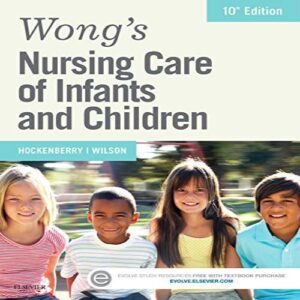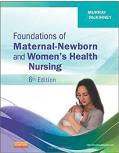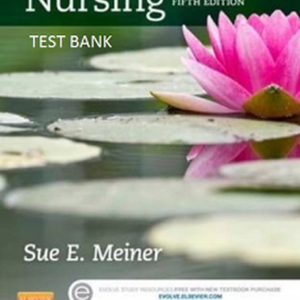Test Bank For Safe Maternity and Pediatric Nursing Care 2nd Edition By Linnard-Palmer
Chapter 1. Introduction to Maternity and Pediatric Nursing
MULTIPLE CHOICE
1. A patient chooses to have the certified nurse-midwife (CNM) provide care during her
pregnancy. What does the CNM’s scope of practice include?
a. Practice independent from medical supervision
b. Comprehensive prenatal care
c. Attendance at all deliveries
d. Cesarean sections
ANS: B
The CNM provides comprehensive prenatal and postnatal care, attends uncomplicated deliveries,
and ensures that a backup physician is available in case of unforeseen problems.
DIF: Cognitive Level: Comprehension REF: Page 6 OBJ: 12
TOP: Advance Practice Nursing Roles KEY: Nursing Process Step: Implementation
MSC: NCLEX: Health Promotion and Maintenance: Prevention and Early Detection of Disease
2. Which medical pioneer discovered the relationship between the incidence of puerperal fever
and unwashed hands?
a. Karl Cred
b. Ignaz Semmelweis
c. Louis Pasteur
d. Joseph Lister
ANS: B
Ignaz Semmelweis deduced that puerperal fever was septic, contagious, and transmitted by the
unwashed hands of physicians and medical students.
DIF: Cognitive Level: Knowledge REF: Page 2 OBJ: 1
TOP: The Past KEY: Nursing Process Step: N/A
MSC: NCLEX: Safe, Effective Care Environment: Safety and Infection Control
3. A pregnant woman who has recently immigrated to the United States comments to the nurse, I
am afraid of childbirth. It is so dangerous. I am afraid I will die. What is the best nursing
response reflecting cultural sensitivity?
a. Maternal mortality in the United States is extremely low.
b. Anesthesia is available to relieve pain during labor and childbirth.
c. Tell me why you are afraid of childbirth.
d. Your condition will be monitored during labor and delivery.
ANS: C
Asking the patient about her concerns helps promote understanding and individualizes patient
care.
DIF: Cognitive Level: Application REF: Page 7-8 OBJ: 8
TOP: Cross-Cultural Care KEY: Nursing Process Step: Implementation
MSC: NCLEX: Psychosocial Integrity: Psychological Adaptation
4. An urban area has been reported to have a high perinatal mortality rate. What information does
this provide?
a. Maternal and infant deaths per 100,000 live births per year
b. Deaths of fetuses weighing more than 500 g per 10,000 births per year
c. Deaths of infants up to 1 year of age per 1000 live births per year
d. Fetal and neonatal deaths per 1000 live births per year
ANS: D
The perinatal mortality rate includes fetal and neonatal deaths per 1000 live births per year.
DIF: Cognitive Level: Comprehension REF: Page 12, Box 1-6
OBJ: 9 TOP: The Present-Child Care
KEY: Nursing Process Step: Implementation
MSC: NCLEX: Safe, Effective Care Environment: Coordinated Care
5. What is the focus of current maternity practice?
a. Hospital births for the majority of women
b. The traditional family unit
c. Separation of labor rooms from delivery rooms
d. A quality family experience for each patient
ANS: D
Current maternity practice focuses on a high-quality family experience for all families,
traditional or otherwise.
DIF: Cognitive Level: Comprehension REF: Page 6 OBJ: 7
TOP: The Present-Maternity Care KEY: Nursing Process Step: N/A
MSC: NCLEX: Health Promotion and Maintenance
6. Who advocated the establishment of the Children’s Bureau?
a. Lillian Wald
b. Florence Nightingale
c. Florence Kelly
d. Clara Barton
ANS: A
Lillian Wald is credited with suggesting the establishment of a federal Children’s Bureau.
DIF: Cognitive Level: Knowledge REF: Page 4 OBJ: 1 | 2
TOP: The Past KEY: Nursing Process Step: Implementation
MSC: NCLEX: Health Promotion and Maintenance: Growth and Development
7. What was the result of research done in the 1930s by the Children’s Bureau?
a. Children with heart problems are now cared for by pediatric cardiologists.
b. The Child Abuse and Prevention Act was passed.
c. Hot lunch programs were established in many schools.
d. Children’s asylums were founded.
ANS: C
School hot lunch programs were developed as a result of research by the Children’s Bureau on the
effects of economic depression on children.
DIF: Cognitive Level: Knowledge REF: Page 4 OBJ: 2 | 3
TOP: The Past KEY: Nursing Process Step: N/A
MSC: NCLEX: Health Promotion and Maintenance: Coordinated Care
8. What government program was implemented to increase the educational exposure of
preschool children?
a. WIC
b. Title XIX of Medicaid
c. The Children’s Charter
d. Head Start
ANS: D
Head Start programs were established to increase the educational exposure of preschool children.
PRIMEXAM.COM
DIF: Cognitive Level: Knowledge REF: Page 3 OBJ: 5
TOP: Government Influences in Maternity and Pediatric Care KEY: Nursing Process Step: N/A
MSC: NCLEX: Health Promotion and Maintenance: Growth and Development
9. What guidelines define multidisciplinary patient care in terms of expected outcome and
the timeframe from different areas of care provision?
a. Clinical pathways
b. Nursing outcome criteria
c. Standards of care. Nursing care plan
ANS: A
Clinical pathways, also known as critical pathways or care maps, are collaborative guidelines
that define patient care across disciplines. Expected progress within a specified timeline is
identified.
DIF: Cognitive Level: Knowledge REF: Page 12 OBJ: 14
TOP: Health Care Delivery Systems KEY: Nursing Process Step: N/A
MSC: NCLEX: Safe, Effective Care Environment: Coordinated Care




